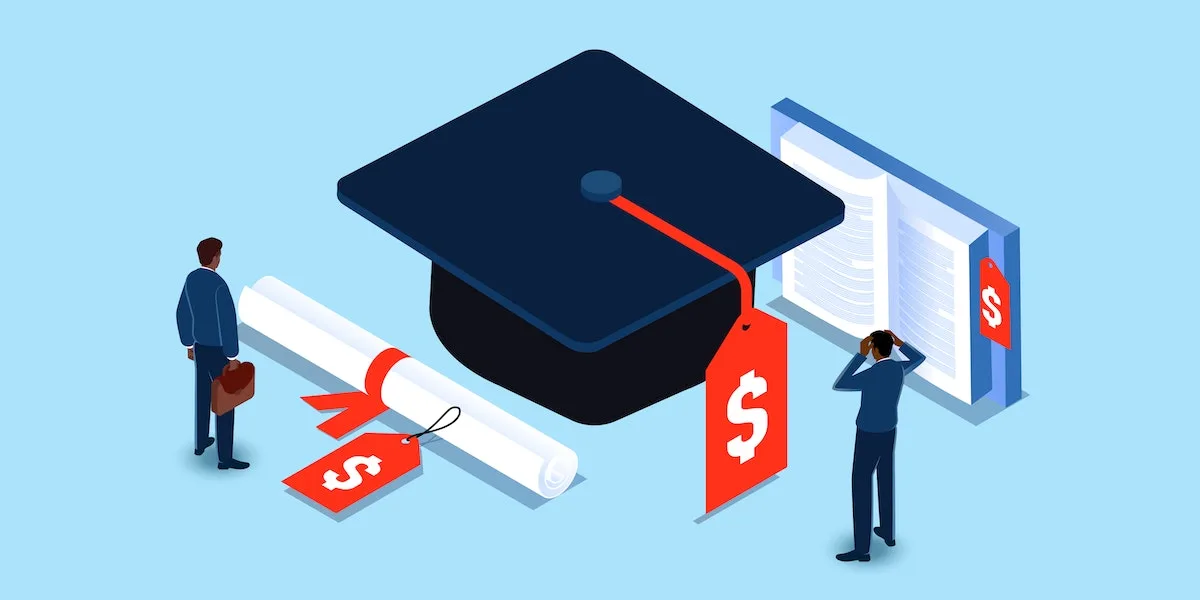What is a Normal Student Loan Payment? : Decoding the Average Tuition Repayment
A normal student loan payment is the amount of money a borrower must pay each month to repay their student loan. This payment is typically determined by factors such as the loan balance, interest rate, and loan term.

Credit: collegeaidpro.com
The Burden Of Student Loans
Student loans have become a significant financial burden for many individuals seeking higher education. The rising costs of tuition and other expenses have made it increasingly challenging for students to afford a college education without borrowing money. As a result, student loans have become the primary means of financing education for countless students around the world.
The Rising Cost Of Higher Education
The cost of higher education has been steadily increasing over the years, making it difficult for students to pay for their education out of pocket. According to recent studies, the average tuition at a public four-year college in the United States has nearly tripled in the past four decades. This rise in tuition costs has far outpaced inflation, leaving students with no choice but to rely on loans to fund their education.
Implications For Borrowers
As students accumulate debt to finance their education, they face a wide range of implications and challenges. The burden of student loans often extends far beyond the college years, affecting borrowers’ financial well-being for years to come.
1. Financial Strain: Paying off student loans can put a significant strain on an individual’s finances. The monthly loan payments can be substantial, especially when coupled with other living expenses. As a result, borrowers may be forced to make sacrifices and live with reduced financial flexibility.
2. Delayed Financial Milestones: Student loan debt can delay important financial milestones, such as buying a home or starting a family. With a significant portion of their income going towards loan payments, borrowers may struggle to save enough for down payments or may feel unable to take on additional financial responsibilities.
3. Limited Career Choices: The burden of student loans can also influence career decisions for borrowers. Graduates may feel pressured to choose higher-paying jobs over pursuing their passions or entering lower-paying industries. This can limit their career choices and impact their overall job satisfaction.
4. Mental and Emotional Stress: Dealing with student loan debt can cause significant mental and emotional stress for borrowers. The constant worry about repaying loans and the fear of falling behind on payments can take a toll on one’s well-being and overall quality of life.
5. Long-Term Financial Impact: The long-term financial impact of student loans should not be underestimated. High levels of debt can affect credit scores, making it harder to secure loans or buy a car in the future. It can also hinder savings for retirement, further impacting borrowers’ financial future.
Overall, the burden of student loans is a pressing issue that affects millions of borrowers worldwide. Addressing the rising cost of education and finding sustainable ways to finance higher education will be crucial in alleviating the burden and creating a brighter financial future for students.

Credit: fastercapital.com
Understanding A Normal Student Loan Payment
A normal student loan payment refers to the average amount that borrowers are required to repay each month to settle their student loans. It’s crucial to understand how this payment is calculated and what factors can impact the repayment amount. By having a clear understanding of the factors affecting repayment amount and typical repayment options, you can make informed decisions about managing your student loan debt.
Factors Affecting Repayment Amount
Several factors influence the amount you need to repay towards your student loan debt. These factors can vary depending on your specific loan agreement and circumstances. The following are some key factors that affect the repayment amount:
- Loan Balance: The total amount you borrowed determines a significant portion of your monthly repayment. The higher the loan balance, the higher your payment amount.
- Interest Rate: The interest rate assigned to your loan impacts the cost of borrowing and the overall repayment amount. A higher interest rate leads to a larger repayment obligation.
- Loan Term: The length of your loan term, typically expressed in months, affects the monthly payment. Longer loan terms generally result in lower monthly payments, but may lead to higher interest payments over time.
- Repayment Plan: The repayment plan you choose can also impact your monthly payment. Different plans have varying structures, such as standard repayment, extended repayment, income-driven repayment, or graduated repayment.
Considering these factors, it’s important to evaluate the details of your loan agreement to understand how they contribute to your monthly payment amount. By doing so, you can better plan your finances and ensure timely loan repayment.
Typical Repayment Options
When it comes to repaying student loans, several repayment options are typically available. These options cater to different financial circumstances and can help borrowers manage their loan payments effectively. The most common repayment options include:
- Standard Repayment: This option requires fixed monthly payments over a specified repayment term, usually 10 years.
- Extended Repayment: Under this option, borrowers have a longer repayment term, typically up to 25 years, resulting in lower monthly payments.
- Income-Driven Repayment: Income-driven plans set monthly payments based on the borrower’s income and family size. The payment amount adjusts as income changes.
- Graduated Repayment: With this plan, payments start low and increase gradually over time, usually every two years. This repayment option is suitable for borrowers whose income is expected to grow over time.
It’s important to note that the specific repayment options available to you may vary based on the type of loan you have and your eligibility. Therefore, it’s advisable to explore the various repayment plans and consult with your loan servicer to determine the best option for your financial situation.
Decoding Average Tuition Repayment
The average student loan payment is a crucial aspect of understanding the financial commitment students face. Deciphering the average tuition repayment involves evaluating the typical student loan debt and the repayment periods. Let’s dive into analyzing these factors to gain a clear understanding of what constitutes a normal student loan payment.
Analyzing Average Student Loan Debt
Student loan debt is a significant financial burden for many individuals. The average student loan debt provides insight into the financial challenges faced by graduates. Here’s a breakdown of the average student loan debt:
- Public 4-year institutions: $25,921
- Private nonprofit 4-year institutions: $32,600
- For-profit institutions: $39,950
Understanding these figures highlights the financial strain that many graduates encounter post-education.
Evaluating Repayment Periods
Repayment periods play a crucial role in determining the normal student loan payment. The average repayment periods vary depending on the type of loan and the individual’s financial circumstances. Here’s a breakdown of the typical repayment periods:
| Loan Type | Repayment Period |
|---|---|
| Federal Direct Subsidized Loans | 10-25 years |
| Federal Direct Unsubsidized Loans | 10-25 years |
| Private Student Loans | 5-20 years |
Understanding the average tuition repayment involves analyzing these repayment periods to comprehend the financial commitment required.

Credit: fastercapital.com
Frequently Asked Questions On What Is A Normal Student Loan Payment?
How Much Should A Student Loan Payment Be?
A normal student loan payment varies depending on factors such as loan amount, interest rate, and repayment term. On average, it can range from $200 to $500 per month. It’s important to consider your financial situation and make sure the payment is affordable without causing undue stress.
Can You Lower Your Student Loan Payments?
Yes, there are options to lower your student loan payments. You can consider income-driven repayment plans that base your monthly payment on your income and family size. Loan consolidation, refinancing, or applying for loan forgiveness programs are also options to explore.
It’s crucial to research and understand the pros and cons of each option before making a decision.
What Happens If You Can’t Afford Your Student Loan Payments?
If you can’t afford your student loan payments, it’s essential to communicate with your loan servicer. They might be able to offer alternative payment plans, such as deferment, forbearance, or extended repayment options. Defaulting on your loans can have serious consequences, such as damage to your credit score and potential legal action.
It’s crucial to explore and exhaust all available options before defaulting.
Conclusion
Understanding what a normal student loan payment looks like is essential for financial planning. By considering factors such as loan amount, interest rate, and repayment term, students can better manage their finances. It’s important to stay informed and seek assistance when needed to avoid financial strain.
Proper planning can lead to a successful loan repayment experience.
{ “@context”: “https://schema.org”, “@type”: “FAQPage”, “mainEntity”: [ { “@type”: “Question”, “name”: “How much should a student loan payment be?”, “acceptedAnswer”: { “@type”: “Answer”, “text”: “A normal student loan payment varies depending on factors such as loan amount, interest rate, and repayment term. On average, it can range from $200 to $500 per month. It’s important to consider your financial situation and make sure the payment is affordable without causing undue stress.” } } , { “@type”: “Question”, “name”: “Can you lower your student loan payments?”, “acceptedAnswer”: { “@type”: “Answer”, “text”: “Yes, there are options to lower your student loan payments. You can consider income-driven repayment plans that base your monthly payment on your income and family size. Loan consolidation, refinancing, or applying for loan forgiveness programs are also options to explore. It’s crucial to research and understand the pros and cons of each option before making a decision.” } } , { “@type”: “Question”, “name”: “What happens if you can’t afford your student loan payments?”, “acceptedAnswer”: { “@type”: “Answer”, “text”: “If you can’t afford your student loan payments, it’s essential to communicate with your loan servicer. They might be able to offer alternative payment plans, such as deferment, forbearance, or extended repayment options. Defaulting on your loans can have serious consequences, such as damage to your credit score and potential legal action. It’s crucial to explore and exhaust all available options before defaulting.” } } ] }